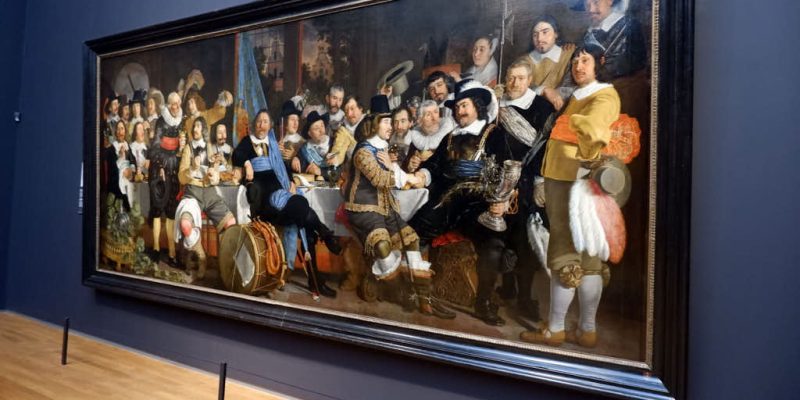Famous Dutch Painters: 10 Powerful Stories Behind Iconic Artists and Their Art

The Netherlands has long been a cradle of artistic talent, particularly during the Dutch Golden Age in the 17th century. The period saw a remarkable flourishing of creativity, giving rise to many famous Dutch painters who left a lasting impact on the art world. These artists not only produced breathtaking works but also lived fascinating lives, filled with stories that influenced their art. In this article, we delve into ten powerful stories behind some of the most iconic artists and their masterpieces, revealing the complexities and inspirations that shaped their work.
Rembrandt van Rijn: The Master of Light and Shadow
Rembrandt van Rijn, one of the most revered famous Dutch painters, was known for his groundbreaking use of light and shadow, a technique known as chiaroscuro. His life was marked by both triumph and tragedy, which greatly influenced his art. Born in 1606 in Leiden, Rembrandt became a masterful storyteller through his paintings.
One poignant story from his life is the loss of his wife, Saskia, who died at a young age. This personal tragedy deeply affected him and is reflected in his later works, where his subjects often convey a sense of melancholy and introspection. One of his most famous paintings, The Night Watch, showcases not just technical brilliance but also an emotional depth that draws viewers into the scene. Today, Rembrandt is celebrated not only for his artistic innovation but also for his ability to evoke powerful emotions through his art.
Johannes Vermeer: The Enigma of Domestic Life
Johannes Vermeer is another of the famous Dutch painters whose work remains eternally captivating. Born in Delft in 1632, Vermeer specialized in intimate scenes of everyday life, often featuring women engaged in domestic tasks. However, his life was not without mystery and struggle.
One fascinating story revolves around Vermeer’s limited output—only about 34 paintings are attributed to him. Despite his undeniable talent, he faced financial difficulties throughout his life and often relied on patronage to survive. Vermeer’s masterpiece, Girl with a Pearl Earring, encapsulates his unique ability to capture fleeting moments and emotions. The painting’s allure lies in the girl’s enigmatic expression, leaving viewers wondering about her thoughts. Vermeer’s ability to blend realism with a sense of mystery continues to enchant art lovers around the world.
Vincent van Gogh: The Turbulent Journey of an Artistic Genius
Vincent van Gogh, one of the most celebrated famous Dutch painters, is known for his vivid colors and emotional depth. His tumultuous life was fraught with struggles, both personal and professional. Born in 1853, Van Gogh faced mental health challenges throughout his life, which greatly influenced his work.
A powerful story from his life is the creation of Starry Night, painted during his time in the asylum at Saint-Rémy-de-Provence. This painting reflects Van Gogh’s inner turmoil and longing for peace. The swirling skies and vibrant stars convey a sense of movement and emotion, capturing the artist’s deep connection to the world around him. Despite his struggles, Van Gogh’s legacy endures, reminding us of the beauty that can arise from pain and suffering.
Frans Hals: The Joy of Life
Frans Hals, a prominent figure among the famous Dutch painters, is known for his lively portraits and exuberant brushwork. Born in Antwerp in 1582, Hals moved to Haarlem, where he became a master of capturing the essence of his subjects. His energetic style reflected the joys of life, making his paintings feel alive.
One interesting story about Hals is how he managed to capture the spirit of the Dutch people during a time of social change. His masterpiece, The Laughing Cavalier, showcases a young man with a beaming smile, dressed in elaborate attire. The portrait radiates joy and confidence, embodying the optimism of the era. Hals’s ability to convey personality through his brushwork has made him a beloved figure among art enthusiasts, solidifying his place among the famous Dutch painters.
Piet Mondrian: The Pioneer of Abstract Art
Piet Mondrian, born in 1872, is often associated with the abstract art movement and is recognized as one of the most influential famous Dutch painters. His journey toward abstraction was a gradual evolution, influenced by his interest in spiritual philosophy and the pursuit of harmony in art.
Mondrian’s most iconic work, Composition II in Red, Blue, and Yellow, represents his quest for balance and simplicity. The painting features a grid of colored rectangles, demonstrating Mondrian’s belief in the universal language of form and color. His approach to art was revolutionary, paving the way for future generations of artists. The story of Mondrian’s transformation from representational to abstract art is a testament to the power of vision and the importance of breaking boundaries in creative expression.
Jan Steen: The Master of Genre Painting
Jan Steen, a lesser-known but significant figure among the famous Dutch painters, was renowned for his genre paintings that depicted lively domestic scenes. Born in 1626, Steen’s work often contained moral lessons wrapped in humor and chaos, reflecting the complexities of daily life in 17th-century Holland.
One engaging story behind Steen’s art is his ability to capture the essence of human behavior. His painting The Feast of Saint Nicholas showcases a joyful holiday celebration filled with lively characters and subtle humor. Steen’s work is a commentary on society, revealing the pleasures and follies of human nature. His ability to blend humor with insight has made him a cherished figure in the art world, reminding us of the richness of everyday life.
Judith Leyster: Breaking Barriers
Judith Leyster was one of the few prominent female artists of the 17th century, carving her path among the famous Dutch painters. Born in Haarlem in 1609, Leyster’s work often focused on genre scenes and portraits, showcasing her talent in a male-dominated field.
One inspiring story from her life is her struggle for recognition. Despite her immense talent, she faced challenges in gaining acknowledgment in a patriarchal society. Her painting The Proposition, which depicts a woman and a man in a conversation, is often interpreted as a commentary on women’s agency. Leyster’s ability to capture the nuances of human emotion and interaction has made her a significant figure in art history, paving the way for future female artists.
Aelbert Cuyp: The Master of Light and Landscape
Aelbert Cuyp, born in 1620, is celebrated for his breathtaking landscapes that capture the beauty of the Dutch countryside. Among the famous Dutch painters, Cuyp is known for his ability to infuse his works with a sense of light and atmosphere, creating serene and idyllic scenes.
One notable story is Cuyp’s connection to the rising bourgeoisie class in the Netherlands. His paintings often featured pastoral scenes, portraying an idealized version of rural life. Works like The Maas at Dordrecht showcase his mastery of light and shadow, immersing viewers in the tranquility of the landscape. Cuyp’s ability to evoke emotion through nature has solidified his place in the canon of famous Dutch painters, inspiring generations of landscape artists.
Theo van Rysselberghe: The Pointillist Innovator
Theo van Rysselberghe, born in 1862, is a key figure among the famous Dutch painters known for his association with the Pointillism technique. His innovative approach to color and light drew inspiration from the works of Georges Seurat, making him a pioneer of this style in the Netherlands.
One compelling story from van Rysselberghe’s life is his role in the avant-garde movement. His painting The Bathers exemplifies his mastery of Pointillism, where small dots of color come together to create vibrant scenes. Van Rysselberghe’s dedication to exploring new artistic techniques demonstrates the importance of experimentation in art, highlighting the dynamic nature of the creative process.
Karel Appel: The Rebel of Modern Art
Karel Appel, born in 1921, represents a shift in the art world, known for his bold and expressive style. As one of the famous Dutch painters, Appel’s work often challenges traditional artistic norms, reflecting the tumultuous times in which he lived.
One powerful story from his life is his role in the CoBrA movement, which sought to break free from established artistic conventions. Appel’s painting The Joy of Life exemplifies his commitment to spontaneity and raw emotion. The vibrant colors and dynamic brushstrokes capture the energy of life itself, making his art a celebration of freedom and creativity. Appel’s rebellious spirit continues to inspire contemporary artists, reminding us of the importance of individuality in art.
Conclusion
The stories behind these famous Dutch painters reveal the profound connections between their lives, their struggles, and their art. From the emotional depths of Rembrandt and Van Gogh to the joyful celebrations of Hals and Steen, each artist has left an indelible mark on the art world. Their masterpieces not only showcase technical brilliance but also reflect the complexities of the human experience, reminding us of the power of art to inspire, provoke thought, and evoke emotions.
FAQs
Q1. What is the significance of the Dutch Golden Age in art history?
The Dutch Golden Age, primarily during the 17th century, was a period of great wealth and cultural flourishing in the Netherlands. It produced many renowned artists and is characterized by innovations in painting techniques, the rise of genre painting, and a focus on realism and light.
Q2. How did Dutch painters influence modern art?
Dutch painters significantly influenced modern art through their exploration of light, color, and perspective. Techniques like chiaroscuro and the use of color theory laid the groundwork for future movements, including Impressionism and Expressionism.
Q3. What are some common themes found in Dutch paintings?
Common themes in Dutch paintings include everyday life, landscapes, still lifes, and portraits. Artists often focused on capturing the beauty of ordinary moments, human emotion, and the interplay of light and shadow.
Q4. Why are portraits so prominent in Dutch art?
Portraits became prominent in Dutch art as the rising middle class sought to celebrate their identity and status through commissioned works. Artists captured not just the likeness but also the personality and social standing of their subjects.
Q5. How did Dutch artists approach the depiction of light in their works?
Dutch artists approached the depiction of light with great skill, often using techniques like chiaroscuro to create depth and drama. They meticulously observed natural light and its effects on color, which added realism and emotional resonance to their paintings.
Also read: Oud West Neighborhood Amsterdam: 10 Reasons Why It’s the Hottest Spot in the City











